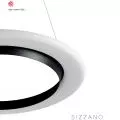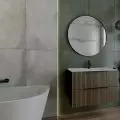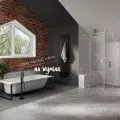In mid-March, as forced isolation began in the wake of the pandemic, culture took over the Internet. Visits to exhibitions in many museums and galleries were launched remotely. But one place in Krakow remained open - the 24-hour accessible window of the Squirrel Center for Contemporary Art.
The SquirrelCCA is an independent contemporary art venue located in the 18th century building of the former Salt Warehouse in Podgórze. Within three years (although the investment will probably be delayed due to the pandemic) a local government cultural institution, the Planet Lem Center for Literature and Language, is to be established here. Before that happens, there is an artistic cluster operating here - artists' studios, conservation studios, music rehearsal rooms, galleries - some of which (and few people know about it) have been here for twenty years. The Squirrel CCA, which has been in operation for a little over a year, is, among other things, the workplace of two visual artists, Bartolomeo Koczenasz and Cecilia Malik, a place for exhibitions and meetings with the public.
Salt Warehouse Building. A sign with the red and yellow logo of the CCA Squirrel hangs next to the entrance.
In the window to the left of the entrance, "Picture from the Storehouse" is presented.
Photo: Katarzyna Jagodzinska
Image from the Storehouse
On March 24, shortly after the streets became deserted and social life froze, the CCA Squirrel announced the beginning of the first installment of the "Image from the Storehouse" project. Each week, the first window to the left of the entrance presents the work of a different artist whose studio is located in the building. Bartolomeo explains:
This was the impetus of the deficit of activities in urban space and culture. We knew that everything was closing down, including the activities we had planned. As I looked at this window, I thought it was very fitting for the situation. The wooden platform we quickly built is a one-man structure, peeking through a small white window, everything is sterile.
The window in which the "Image from the Storehouse" is presented. Wooden steps made of pallets lead up to it.
They are attached to the bicycle railing, because the previous two structures were stolen.
Photo: Katarzyna Jagodzinska
On the one hand, it was a form of offering something to the residents, and on the other hand it was a desire to gather - for the first time - and get to know the creative community present in the Salt Store. Bartolomeo stresses that nowhere in Krakow are there so many artists working under one roof.
and yet there are more windows
This simple endeavor, which has been so refreshing in an age of ubiquitous virtual participation in culture, has remained strangely lonely. Art in public spaces, that in the streets and squares, has remained accessible, but that is not what we are talking about here. Museums and galleries with the opportunity to showcase artistic projects in their storefronts somehow chose not to do so. Some can be mentioned - the MOCAK Museum of Contemporary Art has glass windows, a piece of the first floor of the former Cracovia Hotel (a future branch of the National Museum) is visible from the street, the Bunkier Sztuki has glass doors, and the windows of a number of other institutions are clearly visible from street level. Of course, a public institution operates at a different rhythm than an independent gallery, it is not able to react quickly, it has to plan its budget in advance. I know this from autopsy. But the unique situation the world found itself in required thinking outside the box and acting with the available resources. On the web, most found it great. It simply lacked the touch of the real world in the Polish capital of culture. For whom? For neighbors who passed by going to the grocery store, walking the dog or going to work avoiding taking public transportation. Just that and so much more.
"Image from the Storehouse #8: Piotr Jakubowicz."
Photo credit: Katarzyna Jagodzinska










































